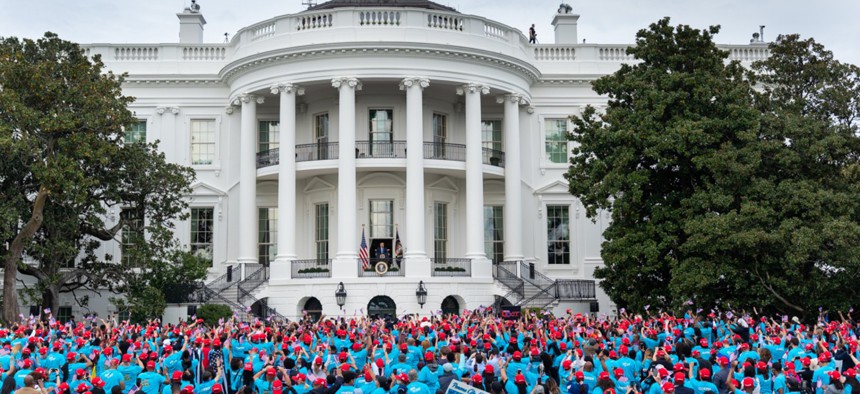
President Trump addresses a "law and order" rally of supporters at the White House on October 10. Official White House Photo by Shealah Craighead
Trump’s Order Sets the Stage for Loyalty Tests for Thousands of Feds
The president’s executive order sweeps aside 140 years of federal policy promoting professional expertise.
With a stroke of his Sharpie, President Trump has launched the biggest effort in history to sweep aside 140 years of federal policy promoting professional expertise in government. It would have a vast impact on government, on its workers, and on the public’s trust in getting a fair and impartial shake from government programs.
On Wednesday, the president signed an executive order creating a new category of federal employees. Top officials could classify positions as having “a confidential, policy-determining, policy-making, or policy-advocating character.” Then they could sweep employees holding those positions into a new “Schedule F,” where employees would lose all protections, including those against discrimination, forced reassignments and relocations, and any rights to organize or appeal personnel decisions, for example. Most important, employees could be dismissed for any reason whatsoever.
The presidential order is the explosive culmination of a volcano that’s been building within the Trump administration to root out public employees viewed as disloyal and part of the “deep state.” President Trump has tweeted that he has the authority “to fire any Executive Branch Employee.” The order puts in place the machinery to make that happen.
But this order would do more than pave the road for a vast transformation of the federal workforce in a second Trump administration. If the administration can meet the tight timetable in the order, the president could define large numbers of current career public servants, who are now protected from political interference, as “policy-making” officials, put them into Schedule F, and order them fired right before the inauguration of a Biden presidency.
The sheer power of the order lies in its simplicity. It does not define what a “policy-determining” or “policy-making” official might be. Indeed, the terms are so broad that they could describe thousands of federal employees. Anthony Fauci’s counsel on how best to guide the nation’s pandemic response could fit the definition. But the administration could argue that the same would be true of a GS-9 analyst deep in the Centers for Disease Control, who analyzes how virus particles spread and writes a memo on the options for using masks to prevent their spread.
Thus, given the order’s unprecedented scope, its fuzziness gives it extraordinary power to uproot employees throughout the federal service. And given the truly astonishing war on expertise that’s muddied the debate on the battle against COVID-19 since the beginning of the pandemic, the order would severely erode trust when it comes to making policy. We elect public officials to use their values in making decisions. We employ career public servants to put the facts before us and to administer the law impartially. If every act of a career public servant is seen through the “policy-determining” or “policy-making” lens, how can we trust the analysis of facts or the impartial application of the law?
Since the creation of the federal civil service with the 1883 Pendleton Act, we have almost 140 years of policy that’s developed our doctrines of fact-based, impartial administration. President Trump’s executive order sweeps it away in just a few pages.
But there’s more. The president asserts the right to change existing federal regulations through an executive order. Now those regulations, defined in the U.S. Code and the Code of Federal Regulations, are the product of a process originally set by Congress in the Administrative Procedure Act, passed in 1946. The APA sets out a process that requires the administration to lay out its proposed rules, to provide an opportunity for public comment, and to require the administration to take those comments into account before issuing a final rule. This is part of the delicate balance of power between Congress and the president: Congress delegates broad authority to the executive branch to exercise great discretion in exchange for an open process that allows for public input.
In pushing aside the APA, the executive order dramatically shifts the balance of power away from Congress and towards the presidency. There’s a fierce debate about whether the president can amend existing regulations through executive order, and any actions by the Trump administration to execute that order are certain to end up in court. The ultimate irony of President Trump’s push to confirm Amy Coney Barrett for a seat on the U.S. Supreme Court might be that the conservatives would be his undoing, since it would be hard for conservative justices to embrace such an extraordinary grab for power.
But make no mistake about it: This is an aggressive effort to uproot the traditions of a highly skilled and politically impartial public service that have made the country great for more than a century. It is a bold effort to shift the constitutional balance of power, to weaken Congress, and to push aside the public’s right to participate in the process that shapes the regulations affecting them.
The executive order’s implications for the government’s ability to perform —and for citizens’ trust in government’s impartiality—could not be greater. This is a very, very big deal.







